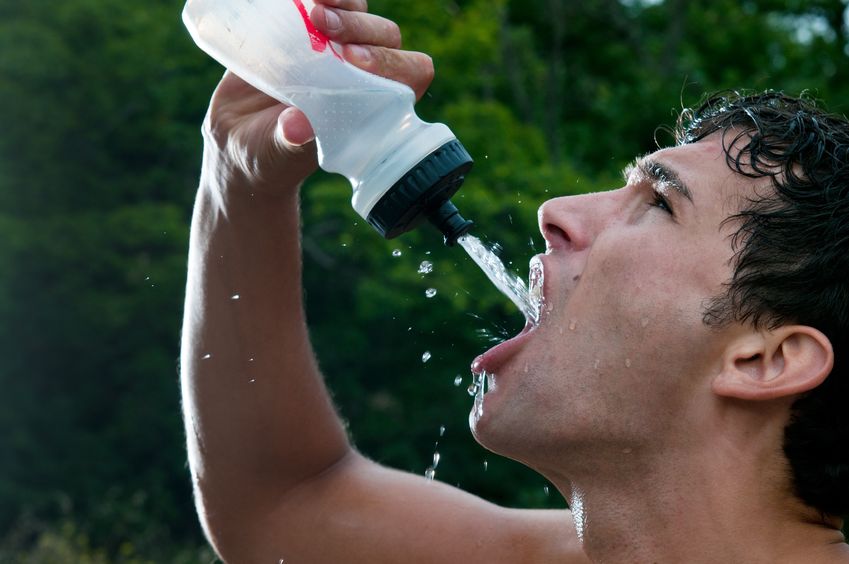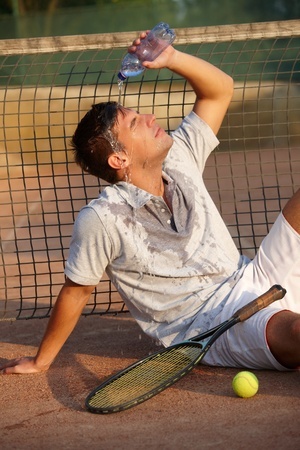Staying Safe in Hot Weather Exercise

Tid Bits of Info
- Recent studies indicate that placing ice on the forearms or palms of the hand can lower the core temperature.
- Drink low sugar content drinks while re-hydrating to facilitate the up-take of water from the gut.
- Early morning is the best time to exercise to take advantage of the radiant cooling effect of nighttime.
- Exercise in a swimming pool when it is extremely hot.
- Use a spray bottle and a fan to help cool yourself when exercising or working in a hot environment.
Working, exercising and playing games in hot weather can be exhausting and even hazardous without proper preparation. Prepare to stay safe during hot weather exercise by taking a few common sense precautions and by learning the signs of heat related illnesses like heat exhaustion and heat stroke.
Maintaining a safe body temperature is essential. Normal body temperature is approximately 98.6 F, and our bodies will respond to hot weather environments through normal physiological processes to maintain that temperature. Sweating is a key part of remaining cool, but this also means that dehydration is a real threat. When dehydration occurs, normal bodily functions can be jeopardized, skill levels begin to falter, and the body faces the threat of heat related illness.
Hydration and Hot Weather Exercise
Our bodies are made up of a lot of water. Approximately 10% of all of the water is in the blood, and this can be depleted if someone is very active in a hot and humid environment. Sweating cools the body during hot weather conditions. The blood flow is shifted to transport more blood to the surface or skin and with it comes the heat within the body. As we sweat, the water in the sweat evaporates from the skin.
In dry, hot conditions the amount of water or sweat needed to cool the system is less than in hot, humid conditions because the amount of water that evaporates is different. In hot, humid weather there is minimal evaporation due to the amount of moisture in the air. Consequently the body sweats more profusely in an attempt to reduce the temperature. Replenishing the lost water due to sweat is essential to prevent dehydration and possible injury or death.
Everyone is susceptible to the effects of hot weather conditions. People who work or exercise outside must take proper precautions. Also, the chronically ill, obese, cardiac patients, infants and elderly people are all prone to the negative effects of a hot environment due to their inability to cool their systems via sweating. Their ability to transport blood to the skin to allow the sweating and evaporation process to occur is severely limited in some cases.
Preparing for Hot Weather Exercise
Here are some common sense tips to prevent dehydration and heat-related illnesses:
 Stay hydrated: If you wait to “feel thirsty” you are already beginning to get dehydrated. Drink fluids (preferably cool/cold water) well before you begin to be active in the hot weather. Avoid drinks that at loaded with sugar. Some sports drinks have a lot of sugar in them and this prevents easy up-take in the gut. Attempt to drink approximately 4-6 oz of cool water while you exercise every 10-15 min. Post activity is a critical time to re-hydrate. You should continue to drink until your urine is a very pale yellow color.
Stay hydrated: If you wait to “feel thirsty” you are already beginning to get dehydrated. Drink fluids (preferably cool/cold water) well before you begin to be active in the hot weather. Avoid drinks that at loaded with sugar. Some sports drinks have a lot of sugar in them and this prevents easy up-take in the gut. Attempt to drink approximately 4-6 oz of cool water while you exercise every 10-15 min. Post activity is a critical time to re-hydrate. You should continue to drink until your urine is a very pale yellow color.- Wear proper clothing: Choose loose, light colored clothes. You may also consider one of the many new fabrics made to help “wick” away the sweat from the skin in an attempt to help the cooling process. There are also some fabrics that are designed to be a sunscreen. All of these fabrics are great, but if the sweat does not evaporate, your body will remain over-heated.
- Choose exercise times wisely: DO NOT go out and exercise in the extreme heat or at the time of the day when the sun is at its hottest. If your schedule requires you to be outside at a high heat time, attempt to do so in the shade by choosing a location that will prevent you from being in the direct sun light. In most cases, early morning workouts are the coolest and secondly late evening as the sun begins to set for the day.
- Get acclimated: If you are continuously active in hot weather conditions, your body will adjust, acclimating to the heat. This process takes time and slow but steady preparation. Begin the process by going shorter time periods and at a less intense pace. Slowly increase both intensity and time over a course of several days. It is crucial that you re-hydrate after each session and do not perform another workout until the re-hydration process is complete. Remember: the lack of complete re-hydration will make you more susceptible to de-hydration every time you are active in the hot weather environment.
- Cool down: When finished working or exercising in the hot weather be sure to spend the re-hydrating time period in a cool environment. This will ease the body’s ability to reduce core and joint temperatures and enable it to return to the normal body temperature and allow the re-hydration of the blood and cells to occur.
Signs of Over Heating
There is no way to completely avoid being active in a hot weather environment. Be sure to know the signs of over heating. The first phase is heat exhaustion. If the treatment process does not begin immediately to reduce the body temperature and re-hydrate the heat-related condition can proceed to heat stroke.
Signs of Heat Exhaustion: Heavy sweating, nausea or vomiting, weakness, dizziness, disorientation, muscle cramps, headache, paleness, fatigue, faint.
Signs of Heat Stroke: Elevated body temperature (103F or higher), no sweating, shallow breaths, rapid heart rate, intense headache, confusion, dizziness and fainting.
If you are with someone who appears to be suffering from heat stroke, CALL 911 IMMEDIATELY! While you wait for help to arrive, try to cool the patient in any form possible. Get them out of the sun, put cool wet towels on their head, put them in a cold pool or tub of water, rub them down with rubbing alcohol, fan them, place ice on the back of their neck, forearms, groin, armpits and try to get them to drink cool/cold water.
Exercise and all activity in hot weather does not have to be avoided, but proper pre-cautions must be taken to make is safe and effective. Always try to stay hydrated during the activity and be sure to re-hydrate entirely following the conclusion of the activity.

























I think the most important thing to remember is to prepare BEFORE you exercise, especially in the hot weather we are currently experiencing. By hydrating enough and eating the right foods and vitamins, you can help nourish your body before losing all the fluids while exercising. Earlier this week, my CrossFit class’s workout involved running outside. Granted we were only outside for maybe 2 minutes at a time but it was extremely hot. I made sure to drink plenty of water before, during, and after my workout to make sure I didn’t get dehydrated. Also the coaches brought in huge fans to use while we are inside doing the workouts because they do not have AC there. I think there is a self-responsibility to not overheating and/or staying hydrated but that becomes difficult in this fast paced world. We have to continuously stay conscious of the people around us and how they are responding to not only exercise, but to the heat in general.
Last summer my friend convinced me to try a CrossFit gym with her, and even though there are many other concerns with this type of gym, it concerned me that all of the workouts were either outside in a parking lot or within a huge metal garage. That summer was particularly hot, and many people were faced with overheating and dehydration. The coaches were sure to remind everyone to drink water, however they continued to push their clients to the edge of exhaustion with long workouts in the hot sun or a stuffy gym. This article is a great guide for anyone who wants to safely lead an active lifestyle during the summer or in a hotter climate.